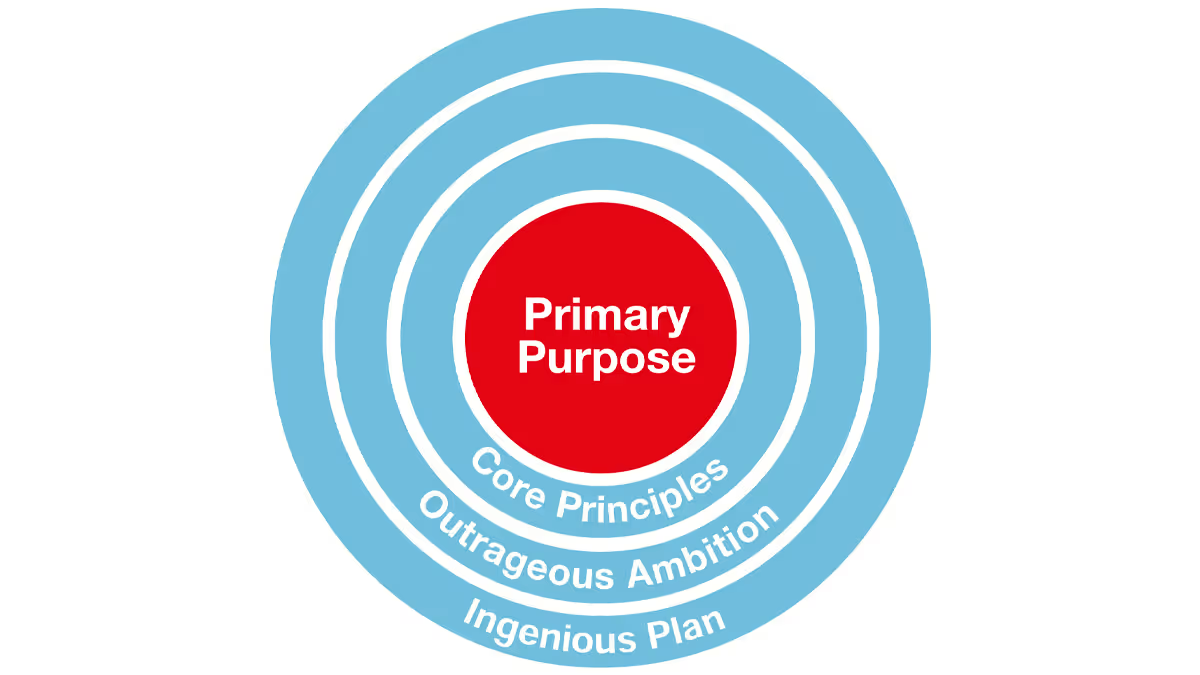
Catch up now

The first step on this journey is for companies to understand their own purpose, direction, and strategy. Without this, how can an organisation expect their employees to be truly aligned with the business?
Our data, which you can read more about later in the article, shows that there are four key elements that an organisation needs to look at that support effective business strategies.
These are:

These are the building blocks of every successful organisation. You may already have some in place, even if you refer to them by a different name. However, it is not just about having these elements defined, it is about how effectively they are communicated with everyone within the organisation; if each of these four elements is communicated clearly and effectively, the organisation is going to be set up for success. You can find out more about how industry experts set up their own organisations for success using organisational clarity, below.
Find out how effectively your organisation has created organisational clarity with our Organisational Clarity Assessment - download your free resource!
“Having a clear purpose. So yes, we do construction and civil engineering, but the purpose behind all of that is to improve life...it’s something everyone can resonate with.” - Dawn Moore, Group People & Communications Director, Murphy
A Primary Purpose is how an organisation understands and articulates its reasons for existing beyond making a profit. This is also sometimes referred to as a ‘mission statement’. It asks the fundamental question of “Why are we here?” It should be about, an organisation’s reason for being, why it exists, and the impact it has on the wider world. In other words, when looking at defining its Primary Purpose, a company should look at the ‘why we do it’ before looking at the ‘what we do’ and ‘how we do it’.
Your Primary Purpose should:
“The values of an organisation will be driven from the top. And you’ve got to model those values. You’ve also got to explain where they come from, and why we do the things that we do, and how we do them.” - Rob May, Executive Chairman, ramsac
Core Principles are the beliefs that an organisation has about the behaviours that are required to be a healthy organisation; they’re the behaviours that make an organisation successful. Lots of organisations just manage their KPIs, rather than looking at how they get there. However, the best outcomes happen when managers and leaders balance their time between focusing on meeting business targets and managing the behaviours needed to achieve them.
Your Core Principles should:
“We also have a very clear ambition. We say we want to be the leading family-owned construction business, but actually what we do behind that, which is different, is engage every single employee in helping us decide how we make that happen.” - Dawn Moore, Group People & Communications Director, Murphy

Think about a time when something in your future made you excited in the present. It could be a holiday, your birthday, or even just looking forward to pizza for dinner. This is the same principle that is behind an Outrageous Ambition; a future event that affects your current behaviour.
The most important thing about an Outrageous Ambition is that it is shared by everyone in the organisation. If employees don’t believe in it, then it won’t happen. The best way to create this link is to connect the employees’ own ambitions to that of the company. While it is up to leaders to decide the Outrageous Ambition, the best way to achieve this connection is to get input from the wider organisation.
An Outrageous Ambition should:
“If we think about when people do their best work, they feel confident, they feel highly connected to the organisation, they feel connected to each other, they have great clarity about the job to be done... that they have a suitable level of control... and that they’re suitably challenged.” - Simon Grosse, CEO, FSP
The Ingenious Plan is all about how to get everyone to make the shift into how things are done at the organisation. It does this by connecting the previous three strategic areas. Furthermore, it also defines what is expected of everyone within the business. If people are clear about that, then the company has achieved organisational clarity. As such, the Ingenious Plan needs to be made up of actionable steps that leaders and managers must help to deliver.
Over the past year, we have seen a decrease in organisational clarity and how employees feel about their connection to the company. This is evident through the fact that 46% of surveyed organisations saw an average 3% decrease in scores to the My Company factor; one of the 8 Factors of Engagement that make up the Best Companies methodology. However, it is important to also recognise that the My Company factor is also affected by other factors and so we can’t claim that all of this decrease has been caused by a lack of organisational clarity.
Where we can see more directly how employees feel about organisational clarity is through the statements “The leader of this organisation runs this organisation based on sound moral principles” and “I am inspired by the person leading this organisation”. These statements achieved overall scores of 74.39% and 67.71% respectively.

However, both statements also saw their scores decline in our year-on-year data by so much that they were both in the bottom four statements when it comes to those with the greatest score decreases. In fact, “The leader of this organisation runs this organisation based on sound moral principles” was the statement that’s score decreased the most over the year when looking at its average score across all organisations, with a drop of 1.22%. When we look at just the companies that saw this score decline, this statement saw an average score decline of 3.36%.
Organisations need to refocus on their organisational clarity. This means looking at the Primary Purpose, Core Principles, Outrageous Ambition, and Ingenious Plan again to ensure that they and employees’ values are still aligned, or it could mean looking at how effectively leaders and managers are communicating these to the rest of the organisation. By doing so, companies can reengage their employees, helping to not only increase their scores in the above statements, but also the productivity and performance of their people.
Creating clarity is vital to the success of any organisation, but how do the best companies do this? One of the key topics that came up during our Best Companies Live event was the importance of communication and how making messaging as easy to understand as possible. Dawn Moore, Group People & Communication’s Director at Murphy, said, “Keep it as simple as possible. And when it comes to the methods that you use to create clarity, I think there’s no better people to ask than the workforce that you have about what works in terms of getting that clarity to them”.
Furthermore, Rob May, Executive Chairman at ramsac, underscored this point by talking about how it’s not just communication that is key, but the different ways in which organisations communicate their message that is also vital. “Understanding how each of us communicate and need to be communicated with; we talked about how people need to hear something 11 times, it’s not as straightforward as that, because people need to hear it in the way that they need to hear it.”

Another crucial topic that was discussed was how creating clarity also relied on how the messaging was tied to employees’ own beliefs and ambitions. The easier it is for an employee to relate to a company’s Primary Purpose, Core Principles, Outrageous Ambition, and Ingenious Plan, the clearer it is to them and the more likely they are to get on board.
Simon Grosse, CEO at FSP, highlighted the importance of this when he said, “To the point around how do you create world class clarity? It’s also got to be something that people can care about, that do care about, and can contribute to. Otherwise, all you’re doing is telling people what we care about”.
Moreover, Prof. Adam Boddison, OBE, the Chief Executive Officer at APM, elaborated on this point by talking about how an organisation needs to ensure that its ambitions, and those of its employees, are on the same path. He stated, “If you can align the organisational strategic goals with individuals’ career ambitions, you’re on a kind of win-win. People can see that they’re going to make a difference for the organisation and take themselves to where they want to be”.
Organisations that are looking to create organisational clarity need to start by ensuring that they have a Primary Purpose, Core Principles, Outrageous Ambition, and Ingenious Plan in place, and that what these are is being clearly communicated to all employees.
This starts at the top, and it is the leader's responsibility to make sure that this is happening by both communicating clearly themselves, and by ensuring that managers are reinforcing clarity.
Successful organisations are those that are aligned with their employees and vice versa. This is a key way to drive engagement and performance, resulting in prosperity for everyone.
By clicking the link, you can use the Organisational Clarity Assessment to see how clearly your organisation is communicating its Primary Purpose, Core Principles, Outrageous Ambition, and Ingenious Plan - download your free resource!